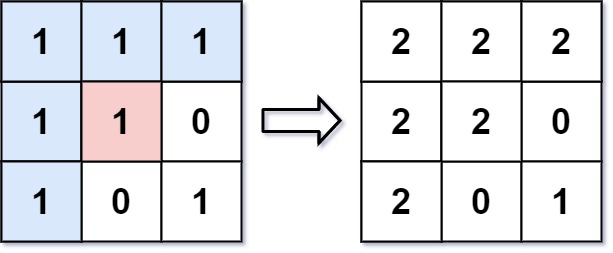733. Flood Fill
Description
You are given an image represented by an m x n grid of integers image, where image[i][j] represents the pixel value of the image. You are also given three integers sr, sc, and color. Your task is to perform a flood fill on the image starting from the pixel image[sr][sc].
To perform a flood fill:
- Begin with the starting pixel and change its color to
color. - Perform the same process for each pixel that is directly adjacent (pixels that share a side with the original pixel, either horizontally or vertically) and shares the same color as the starting pixel.
- Keep repeating this process by checking neighboring pixels of the updated pixels and modifying their color if it matches the original color of the starting pixel.
- The process
stopswhen there are no more adjacent pixels of the original color to update.
Return the modified image after performing the flood fill.
Example 1:
- Input: image = [[1,1,1],[1,1,0],[1,0,1]], sr = 1, sc = 1, color = 2
- Output: [[2,2,2],[2,2,0],[2,0,1]]
- Explanation:

From the center of the image with position(sr, sc) = (1, 1)(i.e., the red pixel), all pixels connected by a path of the same color as the starting pixel (i.e., the blue pixels) are colored with the new color.
Note the bottom corner is not colored 2, because it is not horizontally or vertically connected to the starting pixel.
Example 2:
- Input: image = [[0,0,0],[0,0,0]], sr = 0, sc = 0, color = 0
- Output: [[0,0,0],[0,0,0]]
- Explanation:
The starting pixel is already colored with 0, which is the same as the target color.
Therefore, no changes are made to the image.
Constraints:
- m == image.length
- n == image[i].length
- 1 <= m, n <= 50
- 0 <= image[i][j], color < 216
- 0 <= sr < m
- 0 <= sc < n
💡 Hint 1:
Write a recursive function that paints the pixel if it's the correct color, then recurses on neighboring pixels.
Submitted Code
class Solution(object):
def floodFill(self, image, sr, sc, color):
"""
:type image: List[List[int]]
:type sr: int
:type sc: int
:type color: int
:rtype: List[List[int]]
"""
self.rows = len(image) # 행 개수
self.cols = len(image[0]) # 열 개수
self.target_color = image[sr][sc] # 바꿔야 하는 숫자
def search(r, c):
if image[r][c] != self.target_color:
return
# 값이 target_color라면 color로 변경 후 4방향 체크
image[r][c] = color
if r > 0: search(r-1, c) # 위
if r < self.rows-1: search(r+1, c) # 아래
if c > 0: search(r, c-1) # 왼쪽
if c < self.cols-1: search(r, c+1) # 오른쪽
if self.target_color != color: # (sr, sc)의 값이 color와 같다면 호출 필요 없음
search(sr, sc)
return image
Runtime: 0 ms | Beats 100.00%
Memory: 12.77 MB | Beats 26.64%
특정한 색이 끊기지 않고 연결된 부분에만 새로운 색을 칠해야 하는 문제로, DFS를 사용했다.
Other Solutions
1st
class Solution:
def floodFill(self, image: List[List[int]], sr: int, sc: int, color: int) -> List[List[int]]:
start_color = image[sr][sc] # color로 바꿔야 할 값
def flood_fill(x, y):
if x < 0 or x >= len(image): return # 행 범위 벗어나면 리턴
if y < 0 or y >= len(image[0]): return # 열 범위 벗어나면 리턴
if image[x][y] == color: return # 이미 color와 같은 값이면 리턴
if image[x][y] != start_color: return # 값이 start_color와 다르면 리턴
image[x][y] = color
flood_fill(x-1, y)
flood_fill(x+1, y)
flood_fill(x, y+1)
flood_fill(x, y-1)
flood_fill(sr, sc)
return image
time complexity: 𝑂(𝑚*𝑛)
space complexity: 𝑂(𝑚*𝑛)
재귀 호출에 해당하지 않는 조건들을 먼저 모두 체크해서 리턴시키는 방법도 있다.
2nd
class Solution(object):
def floodFill(self, image, sr, sc, color):
original = image[sr][sc]
if original == color:
return image
seen = set()
self.checkNeighbors(image, original, color, sr, sc, seen)
return image
def checkNeighbors(self, image, original, new, r, c, seen):
seen.add((r, c))
image[r][c] = new
directions = [(1, 0), (-1, 0), (0, 1), (0, -1)]
for dr, dc in directions:
nr, nc = r + dr, c + dc
if (0 <= nr < len(image) and 0 <= nc < len(image[0]) and
image[nr][nc] == original and (nr, nc) not in seen):
self.checkNeighbors(image, original, new, nr, nc, seen)
set()에 이미 방문했던 셀을 저장해서 중복 순회를 막을 수도 있다.



Leave a comment